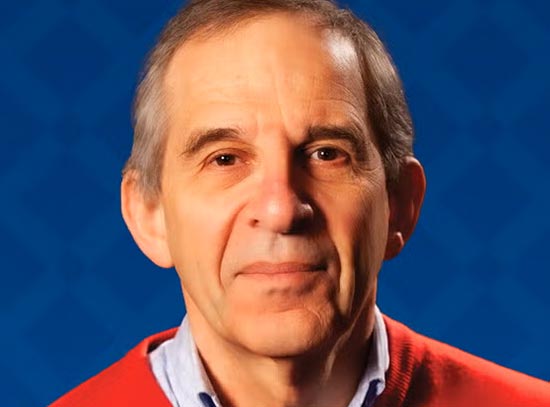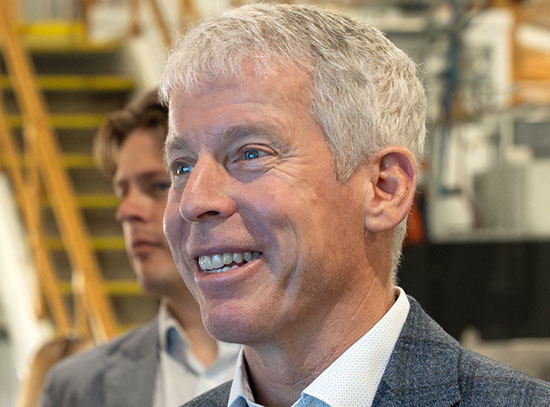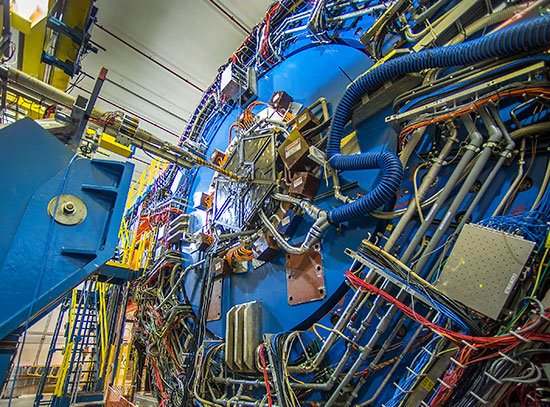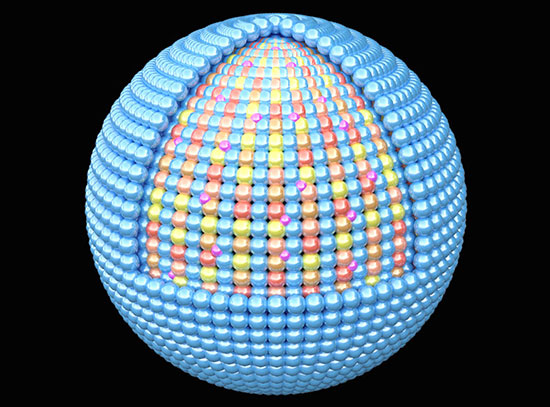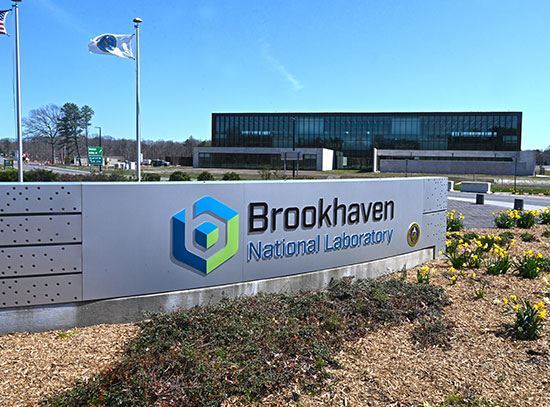Slow Atomic Movements Shed New Light on Unconventional Superconductivity
While atoms are known to wiggle very fast, dopants added to a cuprate superconductor can also cause atoms to meander very slowly. A SLAC study shows this process, called atomic relaxation, offers a new way to explore quantum states in these materials.
December 9, 2024
By Glennda Chui
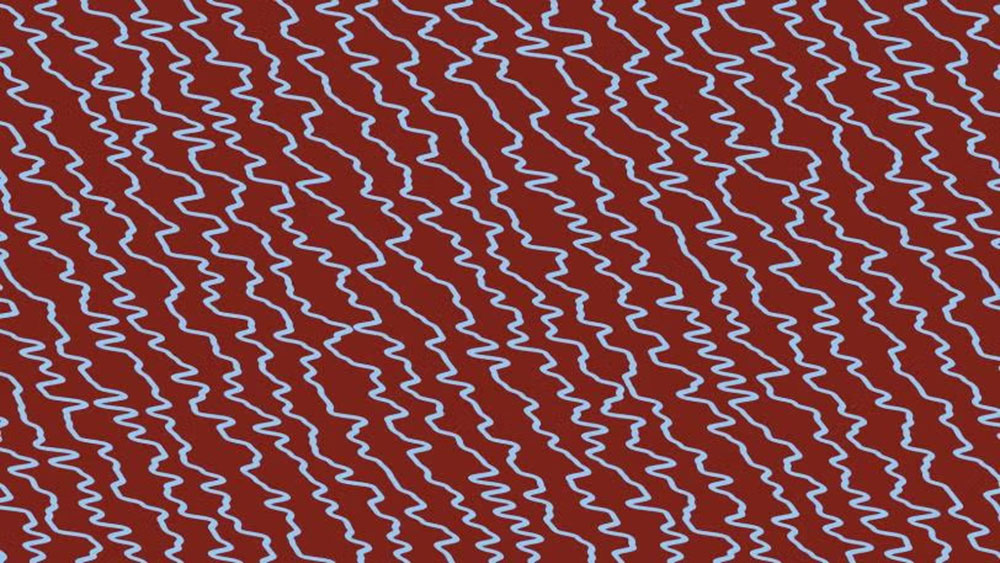
A SLAC research team discovered how an exceedingly slow process known as atomic relaxation changes in the presence of two of the quantum states that intertwine in cuprate superconductors. The results suggest that the relaxation process is a promising tool for exploring and understanding those two states – charge density waves (depicted above), which are stripes of higher and lower electron density in the material, and the superconducting state itself, which switches on when the material chills below its transition temperature. (Greg Stewart/SLAC National Accelerator Laboratory)
Editor’s note: The following article was originally issued by the SLAC National Accelerator Laboratory. The research team studied the atomic relaxation of cuprate superconductors using X-ray photon correlation spectroscopy at the Coherent Hard X-ray Scattering beamline (CHX) at NSLS-II, a U.S. Department of Energy (DOE) Office of Science User Facility at DOE’s Brookhaven National Laboratory. For more information on Brookhaven’s role in this research, contact Denise Yazak (dyazak@bnl.gov, 631-344-6371).
Materials known as unconventional superconductors can conduct electricity with no loss at higher temperatures than regular superconductors. But after 40 years of research, those temperatures are still quite cold – about 140 degrees Celsius below the freezing point of water. Engineering them to operate in much warmer conditions – a development that could spur revolutions in energy, microelectronics and other fields – requires a much better understanding of how these complex materials work.
Almost all the research so far has focused on very fast processes that may contribute to superconductivity – for instance, natural, high-frequency vibrations known as phonons that rattle a material’s atomic latticework trillions of times per second.
Now, a team of researchers led by scientists at the Department of Energy’s SLAC National Accelerator Laboratory have taken a new look from the opposite direction: They observed how an exceedingly slow process known as atomic relaxation changes in the presence of two of the quantum states that intertwine in cuprate superconductors.
The results suggest that the relaxation process is a promising tool for exploring and understanding those two states – charge density waves (CDWs), which are stripes of higher and lower electron density in the material, and the superconducting state itself, which switches on when the material chills below its transition temperature.
The research team described the results today in the Proceedings of the National Academy of Sciences.
Atomic relaxation can be triggered by many things, including doping – the introduction of a new element into a material’s atomic lattice to change its electronic properties. Doping makes the semiconductors in modern electronics possible, and it’s commonly used in research on high-performance materials such as superconductors. In cuprates, it’s used to generate superconductivity.
Atoms of the dopant replace some of the atoms in the material. But since they’re a different size than the atoms all around them, the dopant atom can’t find a comfortable spot to settle. So it slowly meanders between its neighbors, nudging the neighboring atoms to do the same, and keeps on doing that until interrupted.
“This observation of slow atomic motion is a new way to look at things,” said SLAC lead scientist Joshua Turner, a principal investigator with the Stanford Institute for Materials Science and Engineering (SIMES) at SLAC. “It can tell us all sorts of interesting things about what the electrons are doing in systems and materials that many people have been studying for a long time.”
To get a more detailed view, the team turned to the Coherent Hard X-ray Scattering beamline (CHX) at the National Synchrotron Light Source II (NSLS-II), a U.S. DOE Office of Science user facility at DOE’s Brookhaven National Laboratory.
“This beamline provides a high degree of coherence, a specific property of light, and the spatial stability needed to perform this type of experiment. There are very few instruments in the world with these kinds of capabilities,” said Andrei Fluerasu, the lead beamline scientists at CHX.
“This unique X-ray technique has the ability to detect the fascinating dynamics that exist in quantum materials,” added Xiaoqian Chen, who is also a beamline scientist at CHX.
Through this collaboration with the scientists at CHX, the SLAC team found that atomic relaxation took around 1,000 seconds in the cuprate they studied. But to their surprise, atoms meandered farther away from their average positions and relaxation slowed down in the presence of CDWs. Even more surprising, this remarkable effect reversed, and relaxation accelerated, as the cuprate approached its superconducting state.
“This insight gives scientists a whole new way to explore how these quantum states intertwine on slow time scales and to understand the fundamental forces that drive unconventional superconductivity,” said Lingjia Shen, an associate staff scientist with the Linac Coherent Light Source (LCLS) X-ray laser at SLAC who played a leading role in the research.
NSLS II beamline scientists Andrei Fluerasu and Xiaoqian M. Chen contributed to this work, along with researchers from the Massachusetts Institute of Technology, Carnegie Mellon University, the University of Waterloo in Ontario and Lund University in Sweden. Primary funding for this research came from the DOE Office of Science. NSLS-II is a DOE Office of Science user facility.
Citation: Zach Porter et al., Proceedings of the National Academy of Sciences, 4 December 2024 (10.1073/pnas.2412182121)
For questions or comments, contact SLAC Strategic Communications & External Affairs at communications@slac.stanford.edu.
2024-22236 | INT/EXT | Newsroom




